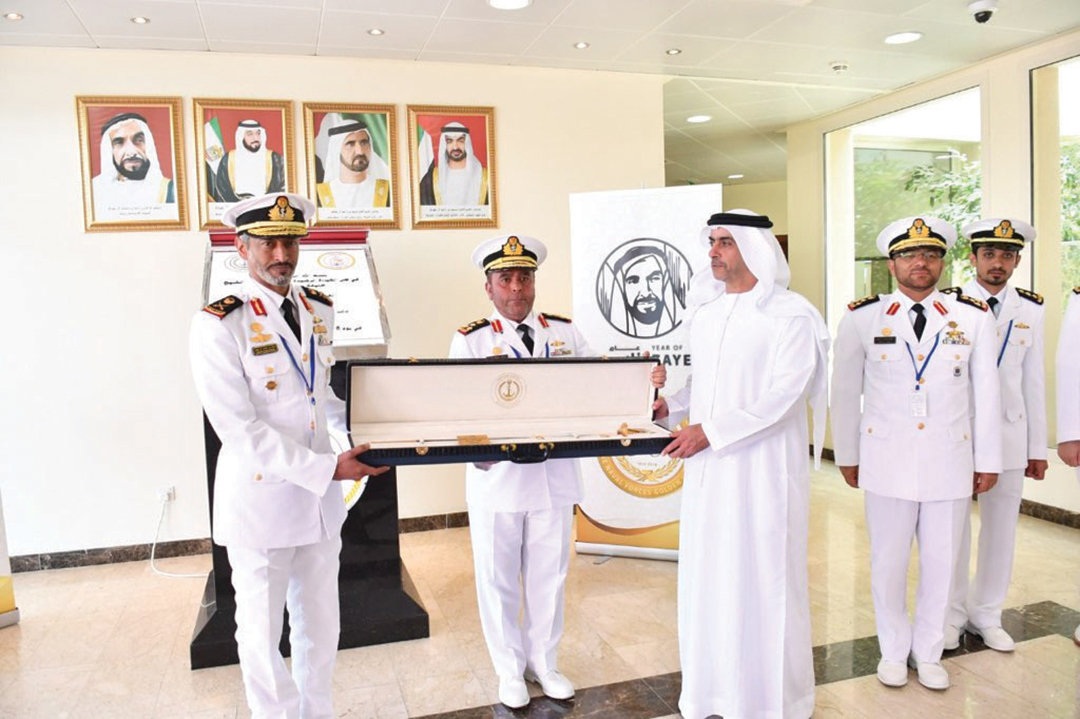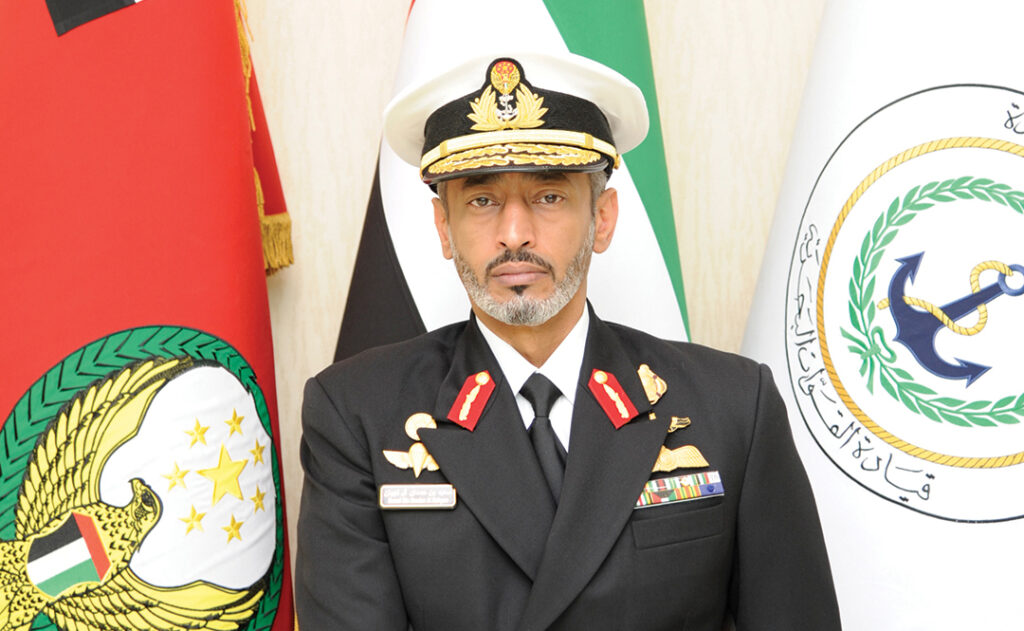COL. RASHID MOHAMMAD AL HAMOUDI, UNITED ARAB EMIRATES SENIOR NATIONAL REPRESENTATIVE TO U.S. CENTRAL COMMAND
Photos by UAE Armed Forces
Rear Adm. Pilot Sheikh Saeed bin Hamdan bin Mohammed Al Nahyan is among the United Arab Emirates’ (UAE) military heroes. Since taking over the helm of the Navy, he has developed the service with the support of the political leadership to ensure combat readiness, professional standards of training and technologically advanced armaments.
Rear Adm. Saeed joined the UAE Armed Forces in 1989 and underwent basic training as a midshipman at the Britannia Royal Naval College in Dartmouth, United Kingdom. After graduating with distinction in 1990, he was commissioned into the UAE Navy. Throughout his naval career, he has accumulated skills and knowledge to the benefit of his country. He became a naval helicopter pilot upon graduation from Khalifa bin Zayed Air College. In 2000, he successfully completed the Staff Officers Course in the United States and several years later earned a master’s of military science degree from the U.S. Naval War College.

The admiral’s naval career has afforded him vast experience aboard ships and behind the scenes as a staff officer. His operational duties have included serving as a navigation officer and weapons officer. He served as executive officer aboard the frigate Abu Dhabi and commanded a missile boat in the 1st Fleet.
His promotion to the naval staff came with new responsibilities: director of operations and training, director of human resources management and deputy commander of the UAE Navy. He rose to the rank of commodore in 2010 and rear admiral in 2013. In September 2017, he assumed the top command, becoming the eighth commander of the UAE Navy.
His long, illustrious career has earned him the Distinguished Long Service Medal, the Silver Jubilee Medal for the Unification of the Armed Forces, the Kuwait Liberation Medal and the French National Order of Merit.
Guiding the Navy
Because of its extensive coastline and reliance on maritime commerce, the UAE faces numerous challenges and threats to its maritime security. UAE leaders have addressed these challenges and threats by building up naval forces capable of carrying out the duties entrusted to them.
The Navy’s lineage traces back to the Abu Dhabi Defense Force, which established a Sea Wing in 1967. The 1st Fleet of Abu Dhabi was tasked with patrolling the coastline of the Arabian Gulf. An important part of its duties was protecting offshore oil and gas installations. With the establishment of the UAE on December 2, 1971, the country began to unify its Armed Forces under a single command, completing that task in 1976.

The United Arab Emirates Navy comprises a number of different naval units, such as gunboats, Baynunah vessels and corvettes, fast supply vessels, landing craft, and others.
His Excellency Lt. Gen. Eng. Issa Saif bin Ablan Al-Mazrouei, deputy chief of staff of the Armed Forces and joint commander of Yemeni Joint Operations, said in his speech to commemorate the return of naval forces from Yemen: “The Navy alone has been part of three naval task forces, more than 50 different naval units with more than 3,000 combat Sailors, and more than 1,000 naval missions have been conducted through which millions of tons have been transported.”
Military education has benefited from the creation of the Naval Cadet Training College, the Naval School, the Security and Safety Wing and the Simulation Wing. Rear Adm. Saeed has promoted the Navy’s participation in joint exercises with friendly states to refine Sailors’ skills, capabilities and preparedness further. The acquisition of modern weapon systems is also a priority for the admiral.
The UAE has launched an initiative to produce most of its military equipment domestically. Abu Dhabi Ship Building Co., with its main factory in Baynunah, has produced a range of ships and aims to design, develop and manufacture warships suited to the shallow waters of the Arabian Gulf.
Two of the world’s top military exhibitions, the International Defence Exhibition and Conference and the Naval Defence and Maritime Security Exhibition, are held in Abu Dhabi every two years.
Keeping Watch on the Arabian Gulf
One of the principal tasks of the United Arab Emirates (UAE) Navy is to achieve maritime security, maintain freedom of navigation and secure transportation corridors, especially given the geographical position of the country in the Arabian Gulf. Forty percent of the world’s oil — and 90% of Middle Eastern oil exports — transit the Strait of Hormuz. Piracy and sabotage, minelaying, spying on port facilities, and drones are among the threats to maritime security in the region.
In the face of such dangers, the United States and its partners formed an international coalition called Operation Sentinel that unites a number of nations to ensure freedom of navigation in the Arabian Gulf, Gulf of Oman, Gulf of Aden and the southern Red Sea.
On September 9, 2019, the UAE announced its accession to the International Maritime Security Construct, the body that oversees Operation Sentinel. This alliance aims to protect merchant vessels by guaranteeing freedom of navigation and world trade and protect the interests of participating states.
The UAE’s membership in this international coalition — which also includes Bahrain, Saudi Arabia and Great Britain — represents its commitment to supporting regional and international efforts to confront threats to regional and global security. The continuity of energy supplies is critical to the global economy on which the people of the world depend.
The Navy doesn’t restrict its activities to UAE territorial waters, however. It has supplied forces to Combined Task Force 152, a multinational flotilla to combat smuggling, terrorism and other crimes in the Arabian Gulf region.

